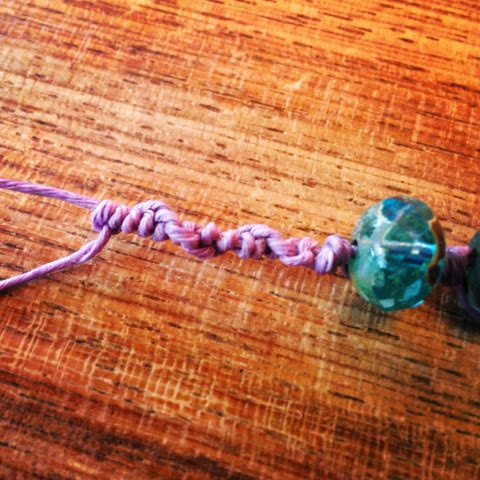If I had a pound for every time someone has asked me if I have written or know of any tutorials on knotting with waxed linen cord, I would be a rich woman.
Every time, I have replied with the response that no, I'm sorry, but I don't know of one/haven't written one, but that I have grand plans to write one! I had some super-grand plans to make a video tutorial for it - and I may do in the future, you never know - but the only way I could think of doing so was to hold my iPhone with my teeth, and I'm not sure I would be able to focus the camera terribly well on what I was doing.....
I must apologise to all the many people I assured I would get a tutorial written that week/month when they asked! It is a really tricky thing to show in photos. However, I decided that a photo tute would be better than no tute, and so....Ta-Da! Here is is! (Please excuse the chipped turquoise nail-varnish by the way....!)
In this tutorial I am using Plum 4ply cord which you can pick up over at The Curious Bead Shop. I would recommend starting out with 4ply - it's a good diameter and comes in a lovely selection of colours. (My personal preference is for 7ply {thicker} when possible, but I use a lot of 4ply too.)
**Please note: this tutorial details how I personally like to knot. Other people like to hold things a little differently, use knotting tweezers or knotting tools and that's what works for them. I've been knotting with silk, linen and cotton for years and this is the way that works for me - I know it works, and I know it works ergonomically, and so I am sharing this way of knotting with you, the only way I can endorse from my own personal experience of knotting. Don't be afraid to experiment beyond this tute however!**

1. Ok, I'm going to start you off just knotting. Not necessarily making a piece of jewellery. I TOTALLY recommend practicing with some spare cord first, to get the hang of placing the knots. Although I am going to show you how I personally do it, I know from experience that we're all different and you may find it easier to hold things a little different to me, to create tension in slightly different ways.....you won't know until you do a bit of knotting yourself, and practicing is a good way of doing it, without the pressure of creating a piece of finished jewellery. So....
Tie an overhand knot.
2. Slide a bead onto the cord, right up to the knot created in 1. Then tie another *loose* overhand knot. You need it to be loose for the minute as you're going to want to take your time tying it so that you can place it precisely - snug against the bead.
3. Position what I call the 'nub of the knot' right against the bead. You can see the loop of the knot is still loose though. You want to gradually shrink this loop...
4.....making it smaller and smaller (you can see I'm using my finger and thumb to push the loop against or into the bead - I only do this when the loop gets pretty tiny)....
5.....until you have two knots, each one snug against the bead.
6. Slide another bead on and repeat the knotting process. You can see here that I am keeping the nub of the knot tight against the bead by creating tension in the loop using my fingers. (I'm right-handed by the way, so this is my non-dominant hand at work here). This is a personal thing - nobody taught me, but it works for me.
7. Here you have two beads knotted side by side, nice and snug. Exactly what you're aiming for. (Excuse the tea stain on my speckledy surface - you don't notice these things til you photograph them sometimes!)
8. Ok, so once you've got the knotting bit down - and it will take a bit of practice for most people, it did for me - then here's a nifty way to start a piece of jewellery with waxed linen cord. Fold the cord over on itself and pass through either a jump ring, or the loop of a toggle clasp such as the heart above.
9. Pass the two tails back through the loop you created, like you would with a gift tag. This is a lark's head knot by the way - there are loads of easy to follow tutorials on YouTube if you are in any doubt. (Note: I have moved the cord OUT of the small loop here so you can see what's going on better in the photo. DON'T do that when you are trying this at home! Keep the cord passed through the small loop.)
10. Pull snug, and there you have a good starting point for your necklace/bracelet! As you've got a double length, you have the choice of a double-strand bracelet, using both lengths of cord at once, or working with one and hiding/decorating the second one as a tail.
11. Here, I've started off knotting with both lengths of cord, using slightly larger-than-average holed beads.
12. And here's how to do those decorative tails. Slide a bead or two on the tail, knot to secure that bead, and you're done. Easy, secure and pretty.
There are so, so many ways of knotting with different sized cord/beads, different numbers of cord going through each bead, different numbers of strands etc.....hopefully, if you've not known where to start with waxed linen cord, this will give you a wee helping hand. Leave any questions for me in the comments!


































